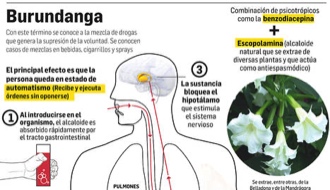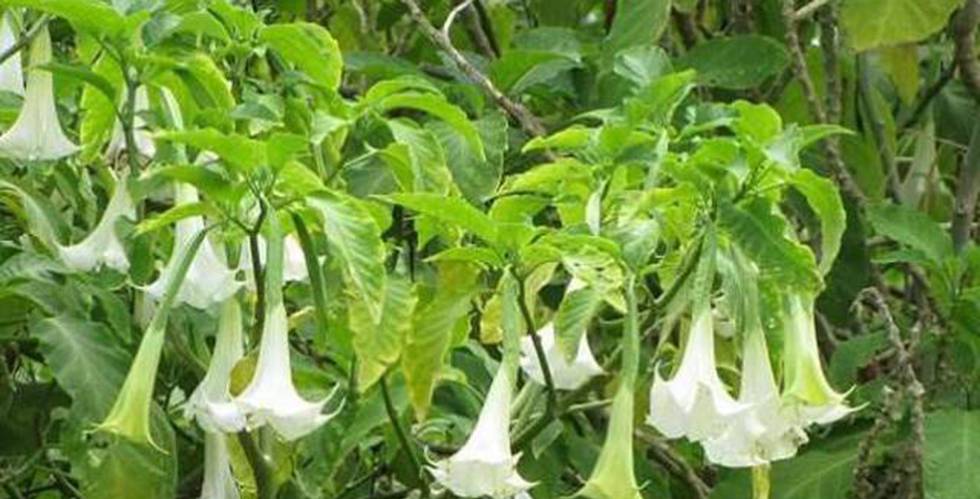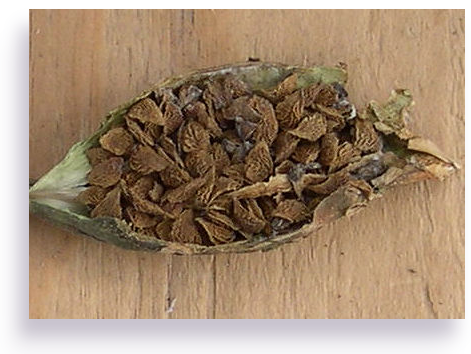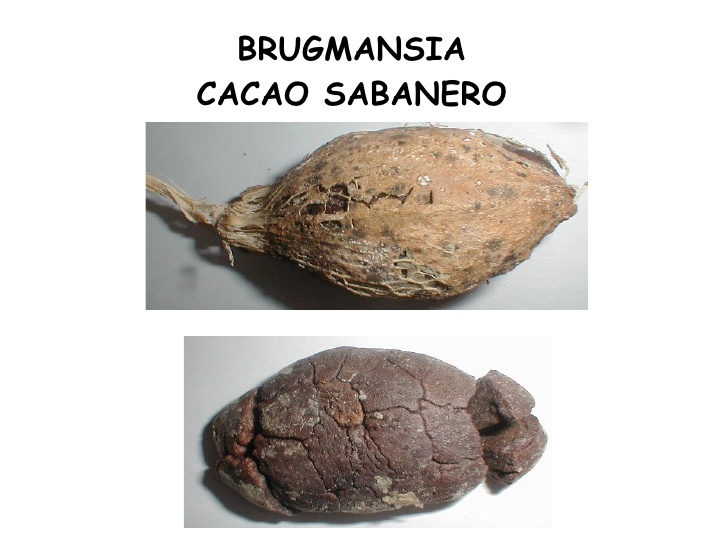
Burundanga/Scopolamine floripondio Angels' trumpet
Borrachero tree, also known as the "drunken binge" tree, a substance derived from it, scopolamine, blocks a person's ability to form memories, and temporarily inhibits his ability to make free will choices.
The borrachero tree, which is marked by beautiful white and yellow blossoms that droop ever so innocuously from the plant's slender branches, holds a secret that few people outside northern South America know about. The tree's seeds, flowers, and pollen possess hallucinogenic chemical substances that, when inhaled or consumed, are capable of eliminating a person's free will, and turning him or her into a mindless zombie that can be fully controlled without any inhibitions. Colombia
A hazardous drug that eliminates free will and can wipe the memory of its victims is currently being dealt on the streets of Colombia. The drug is called scopolamine, but is colloquially known as ‘The Devil’s Breath,' and is derived from a particular type of tree common to South America. Stories surrounding the drug are the stuff of urban legends, with some telling horror stories of how people were raped, forced to empty their bank accounts, and even coerced into giving up an organ.
The most dangerous drug in the world: ‘Devil’s Breath’ chemical from Colombia can block free will, wipe memory and even kill
-Scopolamine often blown into faces of victims or added to drinks
-Within minutes, victims are like ‘zombies’ — coherent, but with no free will
-Some victims report emptying bank accounts to robbers or helping them pillage own house
-Drug is made from borrachero tree, which is common in Colombia

Brugmansia is a genus of seven species of flowering plants in the family Solanaceae. Their large, fragrant flowers give them their common name of angel's trumpets, a name sometimes used for the closely related genus Datura. Brugmansia are woody trees or shrubs, with pendulous, not erect, flowers, that have no spines on their fruit. Datura species are herbaceous bushes with erect (not pendulous) flowers, and most have spines on their fruit.
Brugmansia are native to tropical regions of South America, along the Andes from Venezuela to northern Chile, and also in south-eastern Brazil. They are grown as ornamental container plants world-wide, and have become naturalized in isolated tropical areas around the globe, including within North America, Africa, Australia, and Asia
Linnaeus first classified these plants as part of Datura with his 1753 description of Datura arborea. Then in 1805, C. H. Persoon transferred them into a separate genus, Brugmansia, named for Dutch naturalist Sebald Justinus Brugmans. For another 168 years, various authors placed them back and forth between the genera of Brugmansia and Datura, until in 1973, with his detailed comparison of morphological differences, T.E. Lockwood settled them as separate genera, where they have stayed unchallenged since.
Brugmansia are native to tropical regions of South America, along the Andes from Venezuela to northern Chile, and also in south-eastern Brazil. They are grown as ornamental container plants world-wide, and have become naturalized in isolated tropical areas around the globe, including within North America, Africa, Australia, and Asia
Linnaeus first classified these plants as part of Datura with his 1753 description of Datura arborea. Then in 1805, C. H. Persoon transferred them into a separate genus, Brugmansia, named for Dutch naturalist Sebald Justinus Brugmans. For another 168 years, various authors placed them back and forth between the genera of Brugmansia and Datura, until in 1973, with his detailed comparison of morphological differences, T.E. Lockwood settled them as separate genera, where they have stayed unchallenged since.

Currently, there are 7 recognized species:
Brugmansia arborea (L.) Sweet (Andes - Ecuador to northern Chile)
Brugmansia aurea Lagerh. (Andes - Venezuela to Ecuador)
Brugmansia insignis (Barb.Rodr.) Lockwood ex R.E. R.E.Schult. (Eastern Andes foothills - Colombia to Bolivia and occasionally Brazil)
Brugmansia sanguinea (Ruiz & Pav.) D.Don (Andes - Colombia to northern Chile)
Brugmansia suaveolens (Willd.) Sweet (Southeast Brazil)
Brugmansia versicolor Lagerh. (Ecuador)
Brugmansia vulcanicola (A.S.Barclay) R.E.Schult.. (Andes - Colombia to Ecuador)
These species are then divided into two natural, genetically isolated groups. Brugmansia section Brugmansia (the warm-growing group) includes the species aurea, insignis, sauveolens, and versicolor. Brugmansia section Sphaerocarpium (the cold group) includes the species arborea, sanguinea, and vulcanicola.Two of these species were challenged by Lockwood in his 1973 doctoral thesis. First, Brugmansia vulcanicola was said to be a subspecies of B. sanguinea, but this was refuted by Lockwood's former mentor, R. E. Schultes in 1977. Second, Lockwood proposed that the species B. insignis was instead a hybrid of the combination (B. suaveolens x B. versicolor) x B. suaveolens. This was later disproved by crossbreeding experiments done by the Preissels, published in 1997.
Brugmansia arborea (L.) Sweet (Andes - Ecuador to northern Chile)
Brugmansia aurea Lagerh. (Andes - Venezuela to Ecuador)
Brugmansia insignis (Barb.Rodr.) Lockwood ex R.E. R.E.Schult. (Eastern Andes foothills - Colombia to Bolivia and occasionally Brazil)
Brugmansia sanguinea (Ruiz & Pav.) D.Don (Andes - Colombia to northern Chile)
Brugmansia suaveolens (Willd.) Sweet (Southeast Brazil)
Brugmansia versicolor Lagerh. (Ecuador)
Brugmansia vulcanicola (A.S.Barclay) R.E.Schult.. (Andes - Colombia to Ecuador)
These species are then divided into two natural, genetically isolated groups. Brugmansia section Brugmansia (the warm-growing group) includes the species aurea, insignis, sauveolens, and versicolor. Brugmansia section Sphaerocarpium (the cold group) includes the species arborea, sanguinea, and vulcanicola.Two of these species were challenged by Lockwood in his 1973 doctoral thesis. First, Brugmansia vulcanicola was said to be a subspecies of B. sanguinea, but this was refuted by Lockwood's former mentor, R. E. Schultes in 1977. Second, Lockwood proposed that the species B. insignis was instead a hybrid of the combination (B. suaveolens x B. versicolor) x B. suaveolens. This was later disproved by crossbreeding experiments done by the Preissels, published in 1997.

Uses
Borrachero: World's most dangerous drug from ColombiaBrugmansia are most often grown today as flowering ornamental plants. In modern medicine, important alkaloids such as scopolamine, hyoscyamine, and atropine, found in Brugmansia and other related members of Solanaceae, have proven medical value for their spasmolytic, anti-asthmatic, anticholinergic, narcotic and anesthetic properties, although many of these alkaloids, or their equivalents, are now artificially synthesized.
Brugmansia have also traditionally been used in many South American indigenous cultures in medical preparations and as a ritualistic hallucinogen for divination, to communicate with ancestors, as a poison in sorcery and black magic, and for prophecy. Medicinally, they have mostly been used externally as part of a poultice, tincture, ointment, or where the leaves are directly applied transdermally to the skin. External uses include the treating of aches and pains, dermatitis, orchitis, arthritis, rheumatism, headaches, infections, and as an anti-inflammatory. They have been used internally much more rarely due to the inherent danger of ingestion. Internal uses, in highly diluted preparations, and often as a portion of a larger mix, include treatments for stomach and muscle ailments, as a decongestant, to induce vomiting, to expel worms and parasites, and as a sedative. In a concentrated or refined form, derivatives of Brugmansia are also used for murder, seduction, and robbery.
Several South American cultures have used Brugmansia as a treatment for unruly children, that they might be admonished directly by their ancestors in the spirit world, and thereby become more compliant. Mixed with maize beer and tobacco leaves, it has been used to drug wives and slaves before they were buried alive with their dead lor.
All parts of Brugmansia are poisonous, with the seeds and leaves being especially dangerous. Brugmansia are rich in Scopolamine (hyoscine), hyoscyamine, and several other tropane alkaloids. Effects of ingestion can include paralysis of smooth muscles, confusion, tachycardia, dry mouth, diarrhea, migraine headaches, visual and auditory hallucinations, mydriasis, rapid onset cycloplegia, and death.
The hallucinogenic effects of Brugmansia were described in the journal Pathology as "terrifying rather than pleasurable". The author Christina Pratt, in An Encyclopedia of Shamanism, says that "Brugmansia induces a powerful trance with violent and unpleasant effects, sickening aftereffects, and at times temporary insanity". These hallucinations are often characterized by complete loss of awareness that one is hallucinating, disconnection from reality, and amnesia of the episode, such as one example reported in Psychiatry and Clinical Neuroscience of a young man who amputated his own penis and tongue after drinking only 1 cup of Brugmansia tea.
Borrachero: World's most dangerous drug from ColombiaBrugmansia are most often grown today as flowering ornamental plants. In modern medicine, important alkaloids such as scopolamine, hyoscyamine, and atropine, found in Brugmansia and other related members of Solanaceae, have proven medical value for their spasmolytic, anti-asthmatic, anticholinergic, narcotic and anesthetic properties, although many of these alkaloids, or their equivalents, are now artificially synthesized.
Brugmansia have also traditionally been used in many South American indigenous cultures in medical preparations and as a ritualistic hallucinogen for divination, to communicate with ancestors, as a poison in sorcery and black magic, and for prophecy. Medicinally, they have mostly been used externally as part of a poultice, tincture, ointment, or where the leaves are directly applied transdermally to the skin. External uses include the treating of aches and pains, dermatitis, orchitis, arthritis, rheumatism, headaches, infections, and as an anti-inflammatory. They have been used internally much more rarely due to the inherent danger of ingestion. Internal uses, in highly diluted preparations, and often as a portion of a larger mix, include treatments for stomach and muscle ailments, as a decongestant, to induce vomiting, to expel worms and parasites, and as a sedative. In a concentrated or refined form, derivatives of Brugmansia are also used for murder, seduction, and robbery.
Several South American cultures have used Brugmansia as a treatment for unruly children, that they might be admonished directly by their ancestors in the spirit world, and thereby become more compliant. Mixed with maize beer and tobacco leaves, it has been used to drug wives and slaves before they were buried alive with their dead lor.
All parts of Brugmansia are poisonous, with the seeds and leaves being especially dangerous. Brugmansia are rich in Scopolamine (hyoscine), hyoscyamine, and several other tropane alkaloids. Effects of ingestion can include paralysis of smooth muscles, confusion, tachycardia, dry mouth, diarrhea, migraine headaches, visual and auditory hallucinations, mydriasis, rapid onset cycloplegia, and death.
The hallucinogenic effects of Brugmansia were described in the journal Pathology as "terrifying rather than pleasurable". The author Christina Pratt, in An Encyclopedia of Shamanism, says that "Brugmansia induces a powerful trance with violent and unpleasant effects, sickening aftereffects, and at times temporary insanity". These hallucinations are often characterized by complete loss of awareness that one is hallucinating, disconnection from reality, and amnesia of the episode, such as one example reported in Psychiatry and Clinical Neuroscience of a young man who amputated his own penis and tongue after drinking only 1 cup of Brugmansia tea.

The Swiss naturalist and explorer Johann von Tschudi described the effects of Brugmansia ingestion on one individual in Peru:
Soon after drinking the Tonga, the man fell into a dull brooding, he stared vacantly at the ground, his mouth was closed firmly, almost convulsively and his nostrils were flared. Cold sweat covered his forehead. He was deathly pale. The jugular veins on his throat were swollen as large as a finger and he was wheezing as his chest rose and sank slowly. His arms hung down stiffly by his body. Then his eyes misted over and filled with huge tears and his lips twitched convulsively for a brief moment. His carotids were visibly beating, his respiration increased and his extremities twitched and shuddered of their own accord. This condition would have lasted about a quarter of an hour, then all these actions increased in intensity. His eyes were now dry but had become bright red and rolled about wildly in their sockets and all his facial muscles were horribly distorted. A thick white foam leaked out between his half open lips. The pulses on his forehead and throat were beating too fast to be counted. His breathing was short, extraordinarily fast and did not seem to lift the chest, which was visibly fibrillating. A mass of sticky sweat covered his whole body which continued to be shaken by the most dreadful convulsions. His limbs were hideously contorted. He alternated between murmuring quietly and incomprehensibly and uttering loud, heart-rending shrieks, howling dully and moaning and groaning. Some municipalities prohibit the purchase, sale, or cultivation of Brugmansia plants.
In 1994, 112 teenagers were admitted to hospitals from ingesting Brugmansia in Florida alone. The concentrations of alkaloids in all parts of the plant differ markedly. They even vary with the seasons and the level of hydration, so it is nearly impossible to determine a safe level of alkaloid exposure.
Borrachero: World's most dangerous drug from ColombiaVICE’s Ryan Duffy travelled to the country to find out more about the powerful drug. In two segments, he revealed the shocking culture of another Colombian drug world, interviewing those who deal the drug and those who have fallen victim to it. Demencia Black, a drug dealer in the capital of Bogota, said the drug is frightening for the simplicity in which it can be administered.
He told Vice that Scopolamine can be blown in the face of a passer-by on the street, and within minutes, that person is under the drug’s effect - scopolamine is odourless and tasteless. ‘You can guide them wherever you want,’ he explained. ‘It’s like they’re a child.’ Black said that one gram of Scopolamine is similar to a gram of cocaine, but later called it ‘worse than anthrax.’ In high doses, it is lethal.
The drug, he said, turns people into complete zombies and blocks memories from forming. So even after the drug wears off, victims have no recollection as to what happened.
One victim told Vice that a man approached her on the street asking her for directions. Since it was close by, she helped take the man to his destination, and they drank juice together. She took the man to her house and helped him gather all of her belongings, including her boyfriend’s cameras and savings.
‘It is painful to have lost money,’ the woman said,’ but I was actually quite lucky.’ According to the British Journal of Clinical Pharmacology, the drug - also known as hyoscine - causes the same level of memory loss as diazepam. In ancient times, the drug was given to the mistresses of dead Colombian leaders – they were told to enter their master’s grave, where they were buried alive.
In modern times, the CIA used the drug as part of Cold War interrogations, with the hope of using it like a truth serum. However, because of the drug’s chemical makeup, it also induces powerful hallucinations. The tree common around Colombia, and is called the ‘borrachero’ tree – loosely translated as the 'get-you-drunk' tree. It is said that Colombian mothers warn their children not to fall asleep under the tree, though the leafy green canopies and large yellow and white flowers seem appealing. Experts are baffled as to why Colombia is riddled with scopolamine-related crimes, but wager much of it has to do with the country’s torn drug-culture past, and on-going civil war.
Soon after drinking the Tonga, the man fell into a dull brooding, he stared vacantly at the ground, his mouth was closed firmly, almost convulsively and his nostrils were flared. Cold sweat covered his forehead. He was deathly pale. The jugular veins on his throat were swollen as large as a finger and he was wheezing as his chest rose and sank slowly. His arms hung down stiffly by his body. Then his eyes misted over and filled with huge tears and his lips twitched convulsively for a brief moment. His carotids were visibly beating, his respiration increased and his extremities twitched and shuddered of their own accord. This condition would have lasted about a quarter of an hour, then all these actions increased in intensity. His eyes were now dry but had become bright red and rolled about wildly in their sockets and all his facial muscles were horribly distorted. A thick white foam leaked out between his half open lips. The pulses on his forehead and throat were beating too fast to be counted. His breathing was short, extraordinarily fast and did not seem to lift the chest, which was visibly fibrillating. A mass of sticky sweat covered his whole body which continued to be shaken by the most dreadful convulsions. His limbs were hideously contorted. He alternated between murmuring quietly and incomprehensibly and uttering loud, heart-rending shrieks, howling dully and moaning and groaning. Some municipalities prohibit the purchase, sale, or cultivation of Brugmansia plants.
In 1994, 112 teenagers were admitted to hospitals from ingesting Brugmansia in Florida alone. The concentrations of alkaloids in all parts of the plant differ markedly. They even vary with the seasons and the level of hydration, so it is nearly impossible to determine a safe level of alkaloid exposure.
Borrachero: World's most dangerous drug from ColombiaVICE’s Ryan Duffy travelled to the country to find out more about the powerful drug. In two segments, he revealed the shocking culture of another Colombian drug world, interviewing those who deal the drug and those who have fallen victim to it. Demencia Black, a drug dealer in the capital of Bogota, said the drug is frightening for the simplicity in which it can be administered.
He told Vice that Scopolamine can be blown in the face of a passer-by on the street, and within minutes, that person is under the drug’s effect - scopolamine is odourless and tasteless. ‘You can guide them wherever you want,’ he explained. ‘It’s like they’re a child.’ Black said that one gram of Scopolamine is similar to a gram of cocaine, but later called it ‘worse than anthrax.’ In high doses, it is lethal.
The drug, he said, turns people into complete zombies and blocks memories from forming. So even after the drug wears off, victims have no recollection as to what happened.
One victim told Vice that a man approached her on the street asking her for directions. Since it was close by, she helped take the man to his destination, and they drank juice together. She took the man to her house and helped him gather all of her belongings, including her boyfriend’s cameras and savings.
‘It is painful to have lost money,’ the woman said,’ but I was actually quite lucky.’ According to the British Journal of Clinical Pharmacology, the drug - also known as hyoscine - causes the same level of memory loss as diazepam. In ancient times, the drug was given to the mistresses of dead Colombian leaders – they were told to enter their master’s grave, where they were buried alive.
In modern times, the CIA used the drug as part of Cold War interrogations, with the hope of using it like a truth serum. However, because of the drug’s chemical makeup, it also induces powerful hallucinations. The tree common around Colombia, and is called the ‘borrachero’ tree – loosely translated as the 'get-you-drunk' tree. It is said that Colombian mothers warn their children not to fall asleep under the tree, though the leafy green canopies and large yellow and white flowers seem appealing. Experts are baffled as to why Colombia is riddled with scopolamine-related crimes, but wager much of it has to do with the country’s torn drug-culture past, and on-going civil war.

